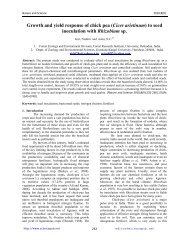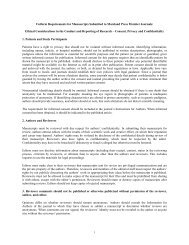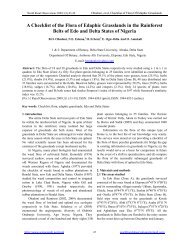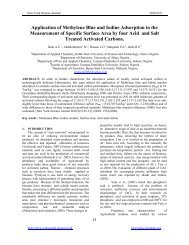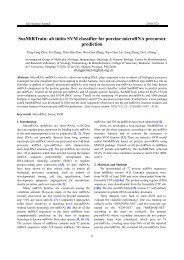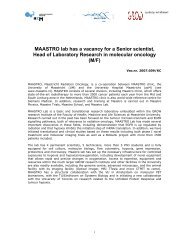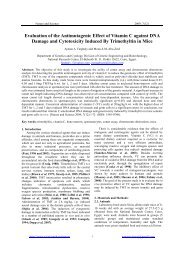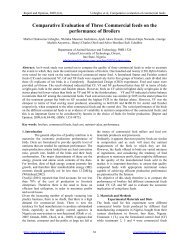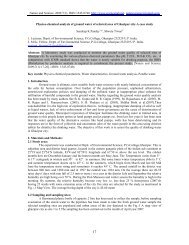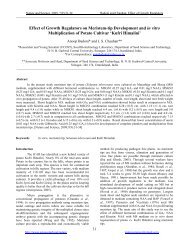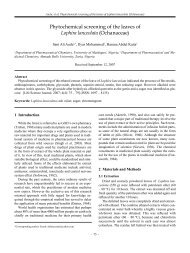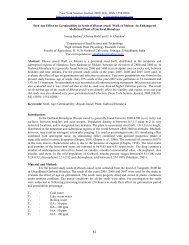Ecological, Social and Commercial Role of Lichens in India with ...
Ecological, Social and Commercial Role of Lichens in India with ...
Ecological, Social and Commercial Role of Lichens in India with ...
You also want an ePaper? Increase the reach of your titles
YUMPU automatically turns print PDFs into web optimized ePapers that Google loves.
Acdemia Arena 2010, Supplement 0201<br />
http://www.sciencepub.net<br />
analysis <strong>of</strong> the vegetation. The impact <strong>of</strong> local people on vegetation, variation <strong>in</strong> floral biodiversity<br />
<strong>and</strong> community <strong>with</strong> changes <strong>in</strong> microclimatic conditions, <strong>and</strong> regeneration status were recorded<br />
dur<strong>in</strong>g 2006.<br />
MATERIALS AND METHODS<br />
Chopta forest is located at 79º-79º30´E longitude <strong>and</strong> 30º30´-30º42´N latitude between<br />
1500-4000m elevation <strong>in</strong> the Garhwal Himalaya. Altitud<strong>in</strong>ally Chopta is located <strong>in</strong> temperate zone.<br />
For the detailed study <strong>of</strong> plant biodiversity <strong>and</strong> other vegetational parameters, the area was divided<br />
<strong>in</strong>to eight forest sites. All the sites are located approximately <strong>with</strong><strong>in</strong> the same elevation range<br />
(2500-3500m).<br />
The Chopta is characterized by its typical climate from temperate to alp<strong>in</strong>e. About 60% <strong>of</strong><br />
the area falls under alp<strong>in</strong>e zone, which rema<strong>in</strong>s under snow dur<strong>in</strong>g w<strong>in</strong>ter months. Broadly, three<br />
seasons can be recognized for the Chopta area, viz. summer (April-June), ra<strong>in</strong>y (July-September)<br />
<strong>and</strong> w<strong>in</strong>ter (October-March). W<strong>in</strong>ter experiences serve cold the ma<strong>in</strong> precipitations are received <strong>in</strong><br />
the form <strong>of</strong> snow. Maximum snow depth occurs <strong>in</strong> the subalp<strong>in</strong>e <strong>and</strong> alp<strong>in</strong>e areas dur<strong>in</strong>g February-<br />
March. With the rise the temperature <strong>in</strong> the month <strong>of</strong> April snow start malt<strong>in</strong>g <strong>in</strong> the lower altitudes<br />
by April it rema<strong>in</strong>s <strong>in</strong> scattered isolated patches below 2800m especially <strong>in</strong> shady localities. Snow<br />
melts only <strong>in</strong> April-May <strong>in</strong> the alp<strong>in</strong>e zone. The ma<strong>in</strong> annual ra<strong>in</strong> fall <strong>of</strong> the Central Himalaya is<br />
2000mm (S<strong>in</strong>gh <strong>and</strong> S<strong>in</strong>gh, 1992). Ra<strong>in</strong>s are mostly conf<strong>in</strong>ed to ra<strong>in</strong>y season <strong>and</strong> heavy down<br />
pours <strong>in</strong> ra<strong>in</strong>y season causes l<strong>and</strong>slides <strong>and</strong> soil erosion.<br />
Total 15 (10mX10m) for trees, sapl<strong>in</strong>gs <strong>and</strong> seedl<strong>in</strong>gs, 40 (2mX2m) for shrubs, <strong>and</strong> 40<br />
(50X50cm) quadrats for herbs <strong>in</strong> each site were placed r<strong>and</strong>omly <strong>and</strong> studied. Regeneration <strong>in</strong> the<br />
forests was sampled at four levels namely mature tree, sapl<strong>in</strong>g <strong>and</strong> seedl<strong>in</strong>g. Mature tree comprised<br />
<strong>of</strong> plants <strong>with</strong> >31.5 cm (gbh) over the bark at breast height (1.37m), sapl<strong>in</strong>g <strong>in</strong>cluded all<br />
<strong>in</strong>dividuals >10.5 cm <strong>and</strong>






